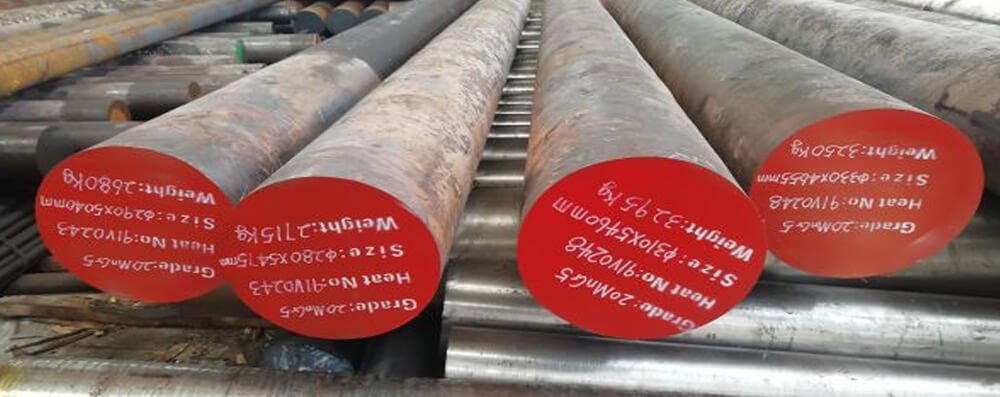Introduction
20MnCr5 is a low-carbon case-hardening alloy steel grade, renowned for its excellent wear resistance, toughness, and core strength after heat treatment. It is particularly suited for producing components requiring a tough core and a hard, wear-resistant surface. The alloy is commonly used in the automotive and mechanical engineering industries where high surface hardness combined with good toughness is essential.
Properties of the Grade:
- Excellent case hardening properties
- High core toughness
- Good fatigue strength
- Excellent wear resistance after carburizing
- Good machinability in annealed condition
- High strength-to-weight ratio
- Good dimensional stability after heat treatment
Uses/Applications of the Grade:
20MnCr5 is extensively used for:
- Gears and pinions
- Shafts
- Crankshafts
- Bushings
- Camshafts
- Axles
- Transmission components
- Gear wheels
- Sleeves and hubs
- Automotive and industrial machinery parts
Chemical Composition:
| Element | Content (%) |
| Carbon (C) | 0.17 – 0.22 |
| Silicon (Si) | 0.40 max |
| Manganese (Mn) | 1.10 – 1.40 |
| Chromium (Cr) | 0.80 – 1.10 |
| Sulfur (S) | 0.035 max |
| Phosphorus (P) | 0.035 max |
Mechanical Properties:
(After Carburizing and Hardening)
| Property | Typical Value |
| Tensile Strength | 1000 – 1300 MPa |
| Yield Strength | 600 – 800 MPa |
| Elongation | ≥ 10% |
| Impact Value (ISO V-notch) | ≥ 40 J |
| Surface Hardness (after Case Hardening) | 58 – 62 HRC |
| Core Hardness | 30 – 45 HRC |
Physical Properties:
| Property | Typical Value |
| Density | 7.85 g/cm³ |
| Modulus of Elasticity | 210 GPa |
| Thermal Conductivity | ~ 46 W/m·K |
| Specific Heat Capacity | ~ 460 J/kg·K |
| Coefficient of Thermal Expansion | ~ 11.7 × 10⁻⁶ /°C |
Forging:
Forging Temperature Range: 850°C – 1150°C
Forging Procedure:
- Heat uniformly to 1150°C and forge down to 850°C.
- Cooling should be done slowly in sand or dry ash to avoid internal stresses.
Heat Treatment:
- Annealing:
- Heat to 630°C – 680°C.
- Hold and cool slowly in the furnace.
- Carburizing:
- Carburize at 880°C – 950°C to achieve a case depth of 0.8mm to 1.2mm.
- Hardening:
- After carburizing, reheat to 780°C – 820°C.
- Quench in oil for maximum hardness.
- Tempering:
- Temper immediately after hardening at 150°C – 200°C to relieve internal stresses.
- Air cooling is recommended.
Dimensional Tolerances:
- Hot Rolled Bars: As per EN 10060 standard tolerances.
- Bright Drawn Bars: Tolerances according to ISO h9/h11 standards.
- Ground Bars: Tight tolerances available up to ISO h6 standard.
Machinability:
- Good machinability when in the annealed condition.
- Carbide or high-speed steel tools are recommended for effective machining.
- Using proper coolant enhances tool life and surface finish.
Corrosion Resistance:
- 20MnCr5 offers moderate corrosion resistance.
- For environments prone to corrosion, protective coatings or surface treatments are necessary.
- Not intended for direct use in highly corrosive environments without treatment.
Weldability:
- Weldable with proper preheating at 200°C – 300°C.
- Post-weld heat treatment is recommended to restore mechanical properties.
- Low hydrogen welding processes (e.g., TIG or MIG) preferred.
Available Form:
20MnCr5 is commonly available in:
- Hot Rolled Round Bars
- Peeled and Ground Bars
- Forged Bars
- Bright Bars
- Customized cut-to-size pieces
- Supplied in annealed or hardened and tempered conditions
Conclusion:
20MnCr5 Alloy Steel Bar is a versatile, low-carbon alloy steel that delivers outstanding performance in case-hardened applications. It provides a strong, tough core and a hard, wear-resistant outer surface ideal for automotive and mechanical components. Its balanced composition, excellent hardenability, and good machinability make it one of the preferred materials for critical, high-performance parts across industries.
Related Products : 16MnCr5, EN19, 42CrMo4, 20MnCr5, EN353, EN31, EN24, EN47, EN41B, SAE4140, SAE52100, SAE 8620, SCM420, EN36C, Maps


